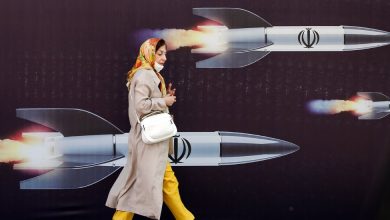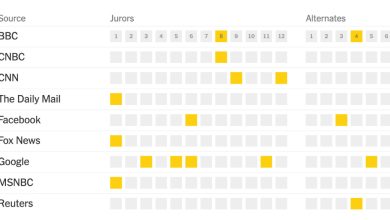Greta Ferusic Dies at 97; Survived Auschwitz and Siege of Sarajevo

Greta Ferusic was 19 when she and her family were taken from their home in Novi Sad, in northern Serbia, to Auschwitz-Birkenau, along with thousands of other Serbian Jews. Known as Greta Weinfeld then, she was the only member of her family to survive the death camps. Nearly 50 years later, after a distinguished career as an architect and a professor, she refused to leave her home in Sarajevo when the siege of that city began.
“Once in my life I had already been forced to leave my home,” she said in “Greta,” a 1997 documentary film about her life during two wars. “I will never again leave my home willingly.”
Ms. Ferusic, thought to be the only person to have survived both Auschwitz and the siege of Sarajevo, which killed more than 11,000 people, died on Jan. 23 at her home in Sarajevo, the capital of Bosnia and Herzegovina. She was 97.
Her son, Edgar, confirmed the death but did not give a cause. Until the end, she wanted to be at home, he said, and not go to a hospital.
For almost four years, beginning in 1992, in what has been described as the longest siege of a city in modern history, Bosnian Serb forces blockaded and shelled Sarajevo, cutting off humanitarian aid along with water, gas and electricity for months at a time as the former Yugoslavia split apart. But Ms. Ferusic and her husband, Seid, a civil engineer, both retired by then, felt as many did that it mattered to keep up a semblance of normal civilized life. (Their son and his wife, Lidija Manuseva, and their two young sons soon left the country, eventually settling in Barcelona, Spain.)
Haris Pasovic, the theater and film director who directed “Greta,” was also in Sarajevo during the siege because he, too, had been determined to help keep the city alive. He continued to put on plays — notably, in 1993, “Waiting for Godot,” with Susan Sontag as director; the theme of Samuel Beckett’s play, an endless wait for an unknown visitor, matched the interminable, impossible conditions of the war. That same year, Mr. Pasovic started the Sarajevo Film Festival.
Ms. Ferusic had been an architecture professor and a dean at the University of Sarajevo and, her son said, the first female architect to teach there. Early in her career she received a scholarship to study in Paris and for a time worked as an urban planner there. In Bosnia, she designed and inspected the construction of hospitals, commercial structures and housing. After her retirement in 1985, she worked as a government minister for the environment.
During the long years of the siege, the Ferusics tried to carry on as usual. They grew accustomed to the pops of sniper fire and the whine of the artillery shells overhead. One day, as Ms. Ferusic recalled in the documentary, a friend came for tea, and as they sat in the living room the friend, feeling the room unsafe, urged them to find one with no windows. They took their teacups into a bathroom. Minutes later, an unexploded shell landed in the living room.
Ms. Ferusic said she was mentally untethered for the first time after that scare and became superstitious, refusing to use the china or the tray that she had brought out that day to serve her guest.
For a long time after, she did not leave her house.
“It wasn’t that I was afraid of being killed,” she said. “I had a terrible feeling of inferiority. Once again in my life, I wasn’t in control of my own destiny.”
What hit her the hardest psychologically, she said, “was the knowledge that this was being done to us not by an invader as in 1941, but people we lived with and worked with and students I had so carefully nurtured.” She added, “Even today I can’t understand it.”
Greta Weinfeld was born on June 26, 1924, in Novi Sad. Her father, Isidor Weinfeld, was a prosperous businessman; her mother, Daniela (Steinitz) Weinfeld, was a homemaker. Greta was an only child and doted on by her extended family, she said.
In Mr. Pasovic’s film, Ms. Ferusic describes the cattle trucks that delivered her family to Auschwitz and the nonchalant gestures of Dr. Joseph Mengele, who became known as the Angel of Death, as he separated the arrivals, some directed to the left, others, like Ms. Ferusic, to the right. Those on the left, including her parents and members of her extended family, were never seen again.
Ms. Ferusic was intent on survival. When the Germans abandoned the camp in January 1945 and forced some 60,000 prisoners to march with them, she managed to stay behind. She weighed just 70 pounds and was clad only in a torn nightgown when the Soviet Army liberated the camp on the 27th of January.
She returned to her home in Novi Sad, and after she had begun to recover, she sold it to pay for her education at the Faculty of Architecture of the University of Belgrade. Mr. Pasovic said he thought that she had chosen architecture because she had seen so much destruction and wanted to build things. (Her son, his wife and their two sons are also architects.)
“One might ask,” Ms. Ferusic said in the film, “how I was able to adapt and make life fairly comfortable for myself. My reason was that it was better to think about the future, and what could be done with it, than to mourn for what is lost.”
Her memory was severely impaired, however, as a result of her deprivations at Auschwitz. Studying was at first nearly impossible; she would instantly forget what she had learned, then force herself to work harder and harder. A grueling math exam was a turning point. Of 440 students in the architecture program, only 40 took the exam, and only 10 passed it, including Ms. Ferusic. Her self-confidence returned, and so did her memory, she said.
She married Mr. Ferusic, a fellow student and a Bosnian Muslim, in 1948, and they moved to Sarajevo. Ms. Ferusic loved traveling, which she did often, mostly with friends. She traveled to Israel alone, however, and said it was the most significant trip of her life. “I never really went around counting people’s nationalities,” she said, “but I have always been proud to have been a Jew.”
In addition to her son, daughter-in-law and grandsons, Ms. Ferusic is survived by two great-grandsons. Her husband died in 2007.
On Jan. 27, International Holocaust Remembrance Day, four days after her death, Bosnian National Television broadcast “Greta” in her honor.




